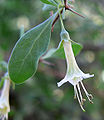Box thorns
| Box thorns | ||||||||||||
|---|---|---|---|---|---|---|---|---|---|---|---|---|

Common wolfberry ( Lycium barbarum ) |
||||||||||||
| Systematics | ||||||||||||
|
||||||||||||
| Scientific name | ||||||||||||
| Lycium | ||||||||||||
| L. |
The box thorns ( Lycium ) are a genus from the nightshade family (Solanaceae) with around 80 species.
description
Box thorns are woody plants with brood-bearing roots. They usually grow upright, creeping or prostrate, are mostly shrubs with heights of 0.5 to 2.5 (4) m, occasionally stunted and up to 20 cm high or small trees with heights of 4 to 5 (10) m. They are occasionally without thorns, but mostly have thorn-covered shoot axes and are often hairy with simple trichomes . The entire leaves are usually in clusters, are sessile or have 2 to 15 mm long stems.
The flowers are axillary, stand individually or on short shoots with flower clusters of 2 to 50 mostly five-fold, rarely four-fold flowers. The flower stalks are (0.5) 1.5 to 10 (20) mm long; the calyx is bell-shaped, tubular or cup-shaped, radial symmetry, zygomorphic or occasionally asymmetrical. The crown is tubular to funnel-shaped, radial symmetry to slightly zygomorphic, white, whitish, greenish-white, greenish-yellow, yellowish-white, cream-yellow, bluish-white, lavender or violet; Occasionally the nerve tracts are purple-black or with greenish, reddish, brownish or purple spots. The crown is 3 to 25 mm long, the petals 1.5 to 5 times shorter than the corolla tube.
The fruits are round or egg-shaped 4 to 6 × 3 to 4, occasionally larger and then up to 8 to 10 mm long. The berry-shaped fruits usually have (2) 4 to 10 (16) or (10) 16 to 40 (70) seeds. Exceptions are the stone fruits of two kinds; the fruits occurring in the species Lycium schaffneri , the endocarp of which hardens and includes 4 seeds; the fruits of the species Lycium macrodon and Lycium puberulum whose two-chambered fruits form a horizontal separation and also have a hardened endocarp in the upper half, so that in the upper chamber there are one or two seeds and in the lower a few stunted ovules and ultimately the Fruit of Lycium cooperi , in which a horizontal separation also appears in the middle of the fruit and separates the two chambers from each other with stone cells , in the upper chamber there are usually only one or two seeds, in the lower five to eight.
Most of the Argentine and Chilean species are visited and fertilized by two or three of the following insect orders: Hymenoptera , Diptera, and butterflies , only Lycium cestroides is visited by hummingbirds .
Occurrence
51 of the 80 species occur in America, 30 in the Old World, of these 17 in southern Africa. They are particularly characteristic of the extra-tropical areas, here they grow from 0 meters to sea levels of 4000 meters, they often grow in soils with a high salt content.
Systematics
The genus includes about 83 species:
photos
swell
Individual evidence
- ^ Rachel A. Levin et al .: Evolutionary Relationships in Tribe Lycieae (Solanaceae) . In: DM Spooner, L. Bohs, J. Giovannoni, RG Olmstead and D. Shibata (eds.): Solanaceae VI: Genomics meets biodiversity. Proceedings of the Sixth International Solanaceae Conference , ISHS Acta Horticulturae 745, June 2007. ISBN 978-90-6605-427-1
- ^ JS Miller and RA Levin: Project Lycieae (online, accessed December 13, 2009)
literature
Armando T. Hunziker: The Genera of Solanaceae , ARG Gantner Verlag KG, Ruggell, Liechtenstein 2001, ISBN 3-904144-77-4 .








